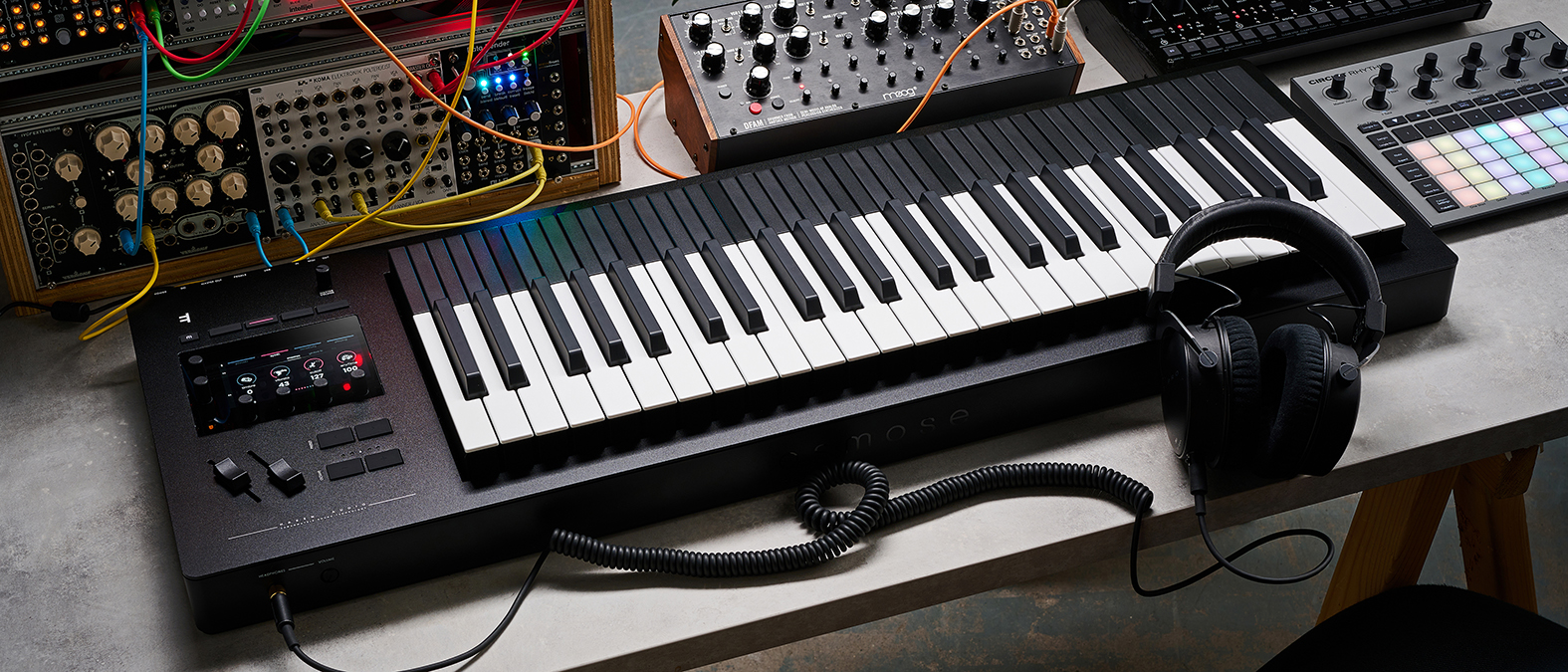MusicRadar Verdict
Osmose could be the all-in-one, future-proof synth/controller keyboard you’ve been looking for.
Pros
- +
Easy transition from traditional keyboards.
- +
Great gestural control and so many sound design possibilities.
- +
Very powerful synth engine inside.
Cons
- -
That synth editor could be overwhelming for some people.
- -
Too much initial setting up.
- -
A little buggy and perhaps not the finished article.
MusicRadar's got your back
Expressive E Osmose: What is it?
The arrival of Osmose was announced back in 2019 and we remember very well our disappointment at a NAMM show, around that time, when Expressive E brought a non-working version to their booth. To say this was a keenly anticipated instrument is an understatement. We’ll forgive them for the delay as Covid probably put a spanner in the works of development, but fast forward a few years and the Osmose has finally broken through a barricade of red tape and arrived on our test studio doorstep.
Osmose is a collaboration between French company Expressive E, of Touché controller fame, and Haken Audio, makers of the Continuum Fingerboard. While it features the same EagenMatrix synth engine, the Osmose takes a slightly more traditional approach with the keyboard, compared to the Continuum’s bright red neoprene playing surface, instead opting for what first appears to be a standard piano keyboard with 49 full-size keys.
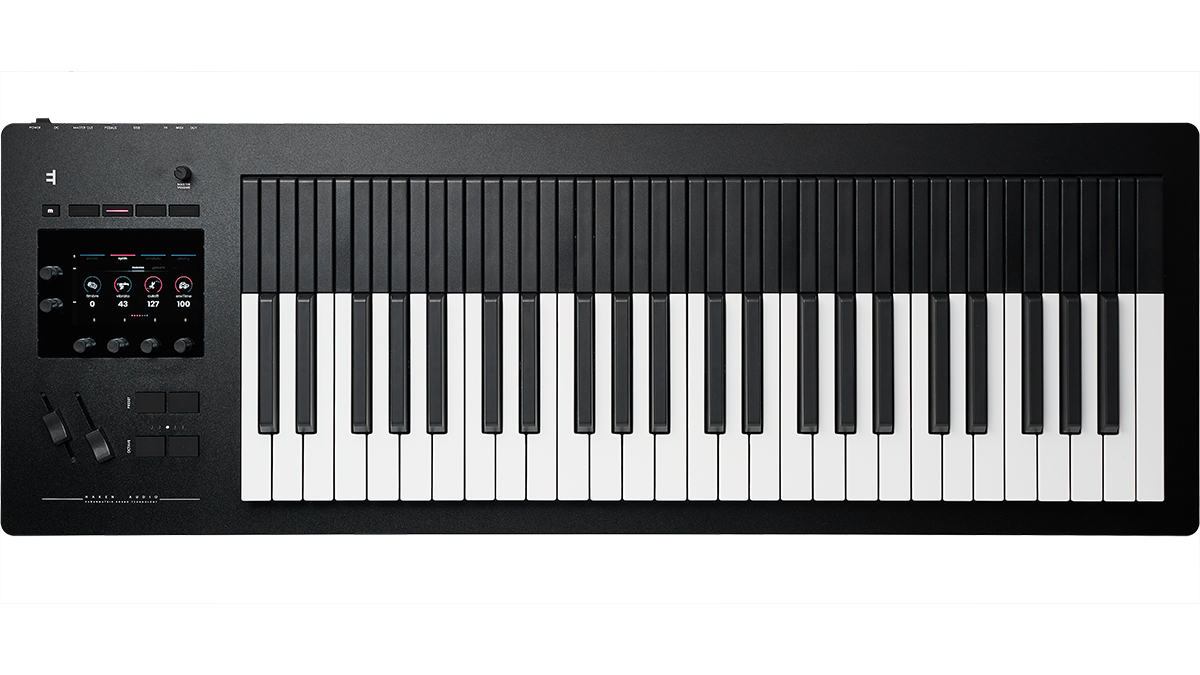
The reality, of course, is far from standard. It is, in fact, a gesture-sensitive, semi-weighted keybed with three-dimensional control, which stands rather proud from the chassis in an almost monumental fashion. This height, of course, is to allow for the extra key travel needed for aftertouch, which we will, um, touch on in a bit. Just above the keys are what was initially thought to be a further set of keys or pads, but turned out to be just extensions of the keys themselves. This ‘longboard’ style of key is what gives enough lateral movement to perform pitch bends, along the x-axis. To the left of the keyboard is the control panel with main volume knob, a colour LCD screen, four macro knobs, four menu buttons, a further two knobs for menu scrolling, octave and preset selection buttons, plus pitch and modulation sliders to the far left.
In the connectivity stakes, on the rear you get two TRS 1/4” line outputs (pseudo-balanced), 5-pin MIDI in and out/thru ports, USB type B and two continuous pedal inputs. Around the front you’ll find a 1/4” TRS headphone output with dedicated volume control. Included in the box is a wall-wart 15v PSU, USB cable and the necessary documentation to help you get started with setup.
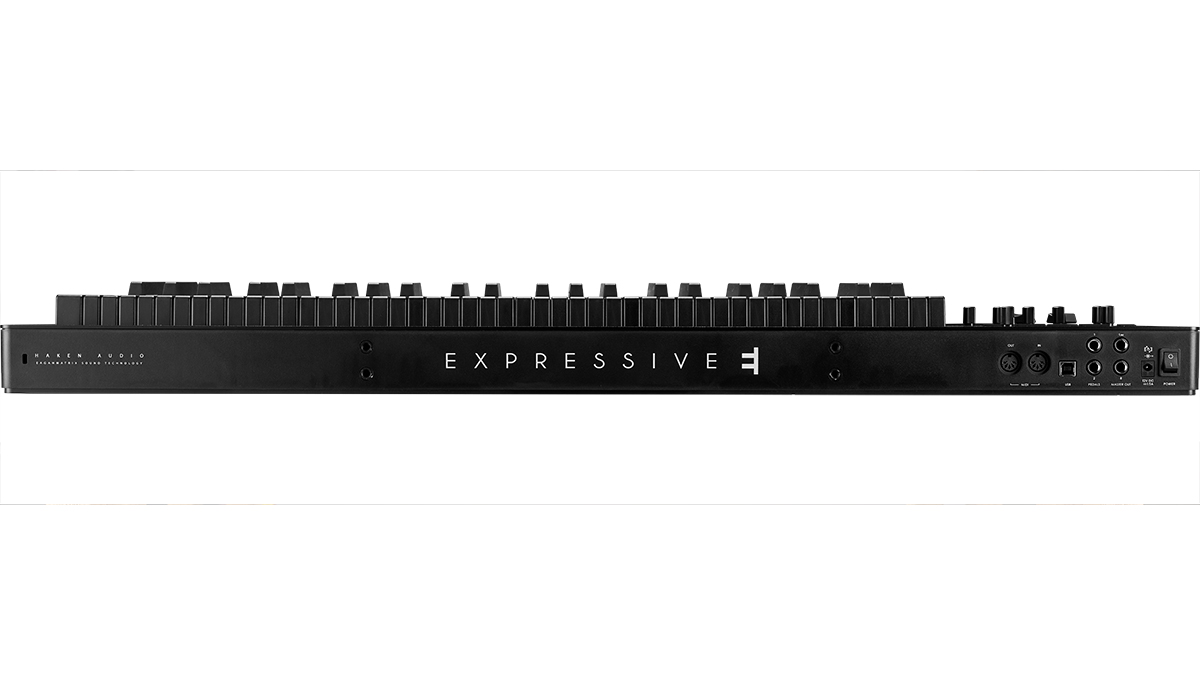
Expressive E Osmose: Performance and verdict
Expressive E describes the keyboard as having three-dimensional control. However, it’s not technically three dimensions in the traditional XYZ-axis sense, as there is no control along the Y-axis (up and down the length of each key), normally found on the squidgier controller counterparts from Roli, Sensel et al. Instead, one dimension is the initial key press movement, the second dimension is the aftertouch and the third is the lateral movement for pitch. This first dimension of movement is pressure sensitive and as with aftertouch, easily mapped to any given control by the sound engine. The X-axis (left to right) control is a little less malleable as it only controls the pitch up to a semitone in either direction, such is the constraint of the hardware.

• ROLI Seaboard Rise 2
The Rise 2 has been greatly improved upon of late, but despite the fact it ships with Equator 2, a very powerful softsynth in its own right, it’s still just a controller so you’ll be forever tethered to a sound source.
• Haken Audio Slim Continuum
Osmose can trace its direct lineage to the Continuum which features the same sound engine, designed by Edmund Eagan and Lippold Haken but instead opts for a completely flat playing surface.
• Ableton Push 3
Ableton's latest iteration of its Push controller instrument is very much a different approach to MPE than your classic keyboard styling, but it offers so much more than the rest.
Unlike other MPE devices there’s no ribbon-like strip to glide the pitch from one end of the keyboard to the other. However, there is a feature to overcome this called Pressure Glide and we actually think it’s far more nuanced than a ribbon strip. You can map the glide between a certain number of notes which render them monophonic, thus leaving the rest of the keyboard polyphonic, or map to the entire length of the keyboard. The best bit is that the glide between notes is pressure sensitive so you can really coax some interesting results from each patch.
The EaganMatrix synth engine is a powerful beast and not for the faint of heart (see more below). This is no more apparent than in the Haken Editor where you can get right under the hood of the modular synth engine. On Osmose itself, the EaganMatrix is represented in a far more streamlined package. Under the synth menu, you’ll find contextual controls per patch. The two encoders to the left will guide you through either the voice controls, or further options for things like effects and global controls. Meanwhile the four macro knobs below the screen make the fine adjustments.
Want all the hottest music and gear news, reviews, deals, features and more, direct to your inbox? Sign up here.
On the hardware, there seems to be no way to start your own patch from scratch. No sign of an initialised preset, where you can select oscillator type and go from there. Instead, you’re left to scroll through presets to find something you’d like to change and save to one of 128 users slots. There are, however, so many presets (500) that you’ll never be stuck for inspiration. Some patches are a bit more vanilla than others when it comes to unleashing Osmose’s full power, but that’s ok.
It serves to show you that this is an instrument for many purposes. It can conjure familiar synth tones from those beloved warm old analogue classics, to the more modern and abrasive hybrid sounds; mimic acoustic instruments and more natural sounds; melt minds with some crazy SFX noise; or combine all of the above within a few short centimetres of movement.
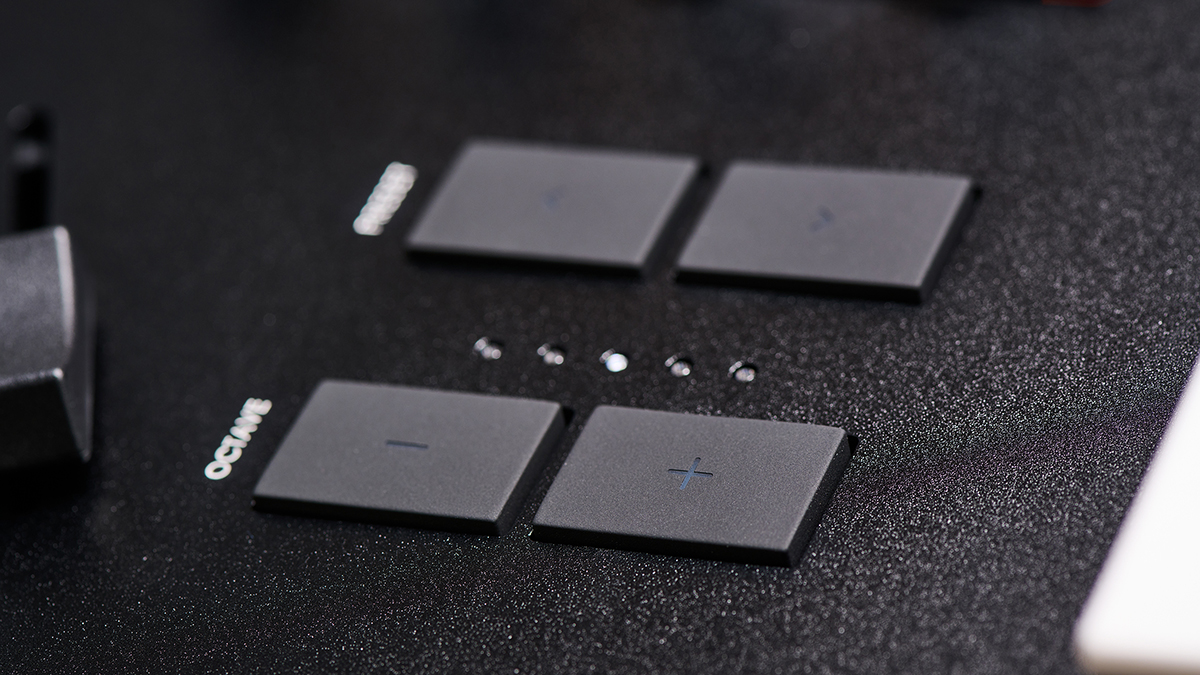
The Playing menu is where you’ll find the arpeggiator and aforementioned glide functions. While the arp feels a little light on some options that you’d expect to find in most synths, it does have a few neat tricks up its sleeve. You can very easily route any of the arp’s features to any part of Osmose’s playing controls, such as setting the ratchet rate to the aftertouch which could produce a strum-like effect, depending on the sound source. Although, one problem we found with this menu is that it doesn’t always display correctly, with most info missing until you start tweaking the menu knobs.
If that’s not enough for you, and you own any MPE-ready hard or soft synths, then Osmose can be easily flipped into controller mode, which also has an option for performing as a classic MIDI controller keyboard too.
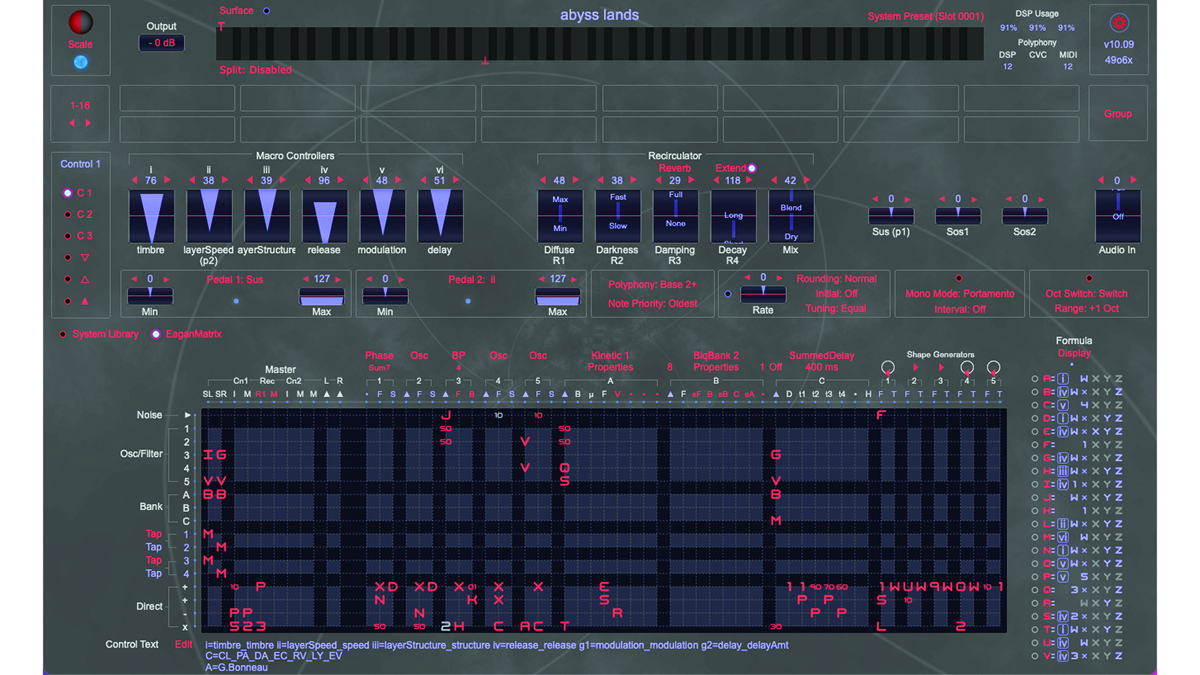
Enter the Matrix
The Edmund Eagan-designed EaganMatrix is the sound engine at the heart of Osmose. It’s a modular digital synth inspired by classic synths from EMS and ARP. Instead of adding a static value at each matrix point – such as pin, as was the case with the Synthi or the 2500 – here you add a whole dynamic formulaic equation, thus opening up vast sonic possibilities. The EaganMatrix features five oscillators, a noise source, five multi-mode filters, five shape generators, time-based delay effects and two biquad filter banks that can also act as granular synth sources. All capable of creating anything from virtual analogue to FM synthesis, to physical modeling and more, though, at this stage you cannot upload your own samples or waveforms. Not that it matters as all of this alone is a staggering amount of control and sonic power.
Osmose power-users will enjoy basking in the power and glory lurking within the EaganMatrix, but those less inclined to see its inner workings will be pleased to know that the hardware’s user interface harnesses all that power within an easy-to-navigate LCD screen and a few macro controls.
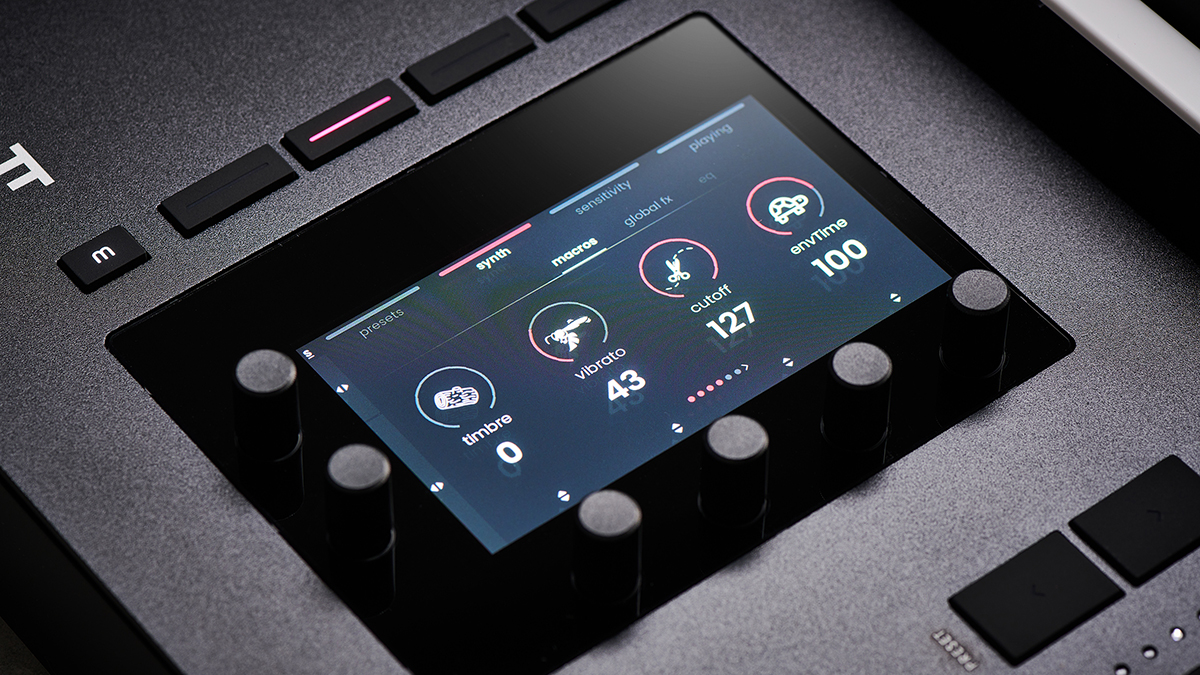
Verdict
As we wrap up with our final thoughts, we should go through some of the things we’ve been less enamoured by. Most notable was the faff in getting Osmose set up. As a product destined to be updated over time, Expressive E has sought to ship it with a factory firmware build, leaving you, the end user, to update it to the latest version upon purchase. This may not sound like much of an issue at the outset, but considering that many of the features were unavailable until the update was performed, it was annoying. It’d be great if future batches could be shipped with at least a fully working firmware build.
Our second annoyance goes out to the Haken Editor which requires Max and is almost ludicrously complex in the GUI stakes. There’s no doubting its power but this is a case where technology gets in the way of what should be, for the most part, an enjoyable experience. Once communication issues between editor and hardware were solved (and there were many) you can really get into the nuts and bolts of every aspect of Osmose, which is great if you’re into that sort of thing. We would’ve preferred less reliance on the editor and a bit more control on the hardware for designing patches.
The most rewarding and playful experience we’ve had with MPE so far
More competent piano/keyboard players may take a while to get used to the action, especially with so much travel for the aftertouch, but it’s still the closest thing to a traditional piano as far as an MPE controller goes. The overall look of Osmose takes us back to those ‘sub keyboard’ synths of the ’70s, like the miniKorg 700, designed to sit atop electric pianos. This design gives you an uncluttered view of the keys and a focus on the exploration of playing as opposed to tweaking. But when it comes to patch tweaking and design there is plenty on offer here, despite the seemingly cramped cockpit. We’d prefer a little more screen real estate and less menu scrolling. That said, the designers have done a great job in making the EaganMatrix sound engine a far simpler affair than the editor would have you believe.
Osmose doesn’t quite feel like the finished article just yet, with certain features missing, but this and the odd bug aside, it’s the most rewarding and playful experience we’ve had with MPE so far. Both Expressive E and Haken Audio have made an MPE instrument that will not confuse or confound traditional keyboard players, but will certainly expand your sonic palette with a highly gestural sound design experience.
MusicRadar verdict: Osmose could be the all-in-one, future-proof synth/controller keyboard you’ve been looking for.
Expressive E Osmose: The web says
"I think what Expressive E have achieved with the Osmose is truly staggering. Personally, I think it’s one of the most exciting electronic instruments to appear in a long time — I’m even tempted to say ‘ever’."
Sound On Sound
Expressive E Osmose: Hands-on demos
Expressive E
True Cuckoo
Andrew Huang
loopop
Andertons Synths, Keys and Tech
Expressive E Osmose: Specifications
- KEY FEATURES 24-voice polyphony, 49 full-size keys with three-dimensional control, standalone synthesizer, MPE Controller and classic MIDI controller.
- I/O: Two ¼” TRS pseudo-balanced line outputs, ¼” TRS headphone output, MIDI In, MIDI Out/Thru, USB Type B.
- DIMENSIONS: 894 x 316 x 87.5mm.
- WEIGHT: 8.3kg.
- CONTACT: Expressive E

I take care of the reviews on MusicRadar and Future Music magazine, though can sometimes be spotted in front of a camera talking little sense in the presence of real musicians. For the past 30 years, I have been unable to decide on which instrument to master, so haven't bothered. Currently, a lover of all things high-gain in the guitar stakes and never one to resist churning out sub-standard funky breaks, the likes of which you'll never hear.
